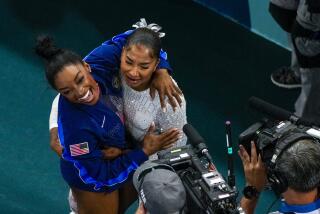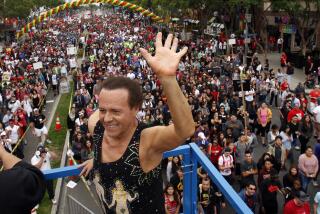Abbye Stockton, 88: Weightlifter Elevated the Status of Women’s Fitness
She was called “the First Lady of Iron,” “America’s Barbelle” and “the Queen of Muscle Beach.”
Abbye “Pudgy” Stockton, a pioneer female weightlifter and women’s gym owner who helped put Santa Monica’s Muscle Beach on the map in the 1930s and ‘40s, died of complications of Alzheimer’s disease Monday at her home in Santa Monica. She was 88.
The Santa Monica-born Stockton was a 19-year-old telephone operator in the late 1930s when she and future husband Les Stockton began frequenting the area just south of the Santa Monica Pier established for devotees of “physical culture.”
Stockton had earned the nickname Pudgy as a young child. But she soon developed what many considered the most impressive female body on Muscle Beach, where weightlifting demonstrations, hand balancing, human-pyramid building, gymnastics, acrobatics and bodybuilding competitions drew large crowds.
She and Les, whom she married in 1941, performed various routines, including the crowd-pleasing “high press,” in which Pudgy lifted a 100-pound barbell over her head while balancing atop Les’ upstretched hands.
“In those days, lifting weights was considered unfeminine,” Stockton told Sports Illustrated Women in 2002.
“People used to say that if women worked out, they would become masculine-looking or wouldn’t be able to get pregnant. We just laughed because we knew they were wrong.”
Stockton, who wrote a column for women called Barbelles in Strength and Health magazine from 1944 to 1954, organized the first Amateur Athletic Union-sanctioned weightlifting meet for women, in 1947.
Around the same time, Physical Culture Magazine publisher Bernarr Macfadden presented Stockton with the Miss Physical Culture Venus award.
“Pudgy was one of the greatest athletes I’ve ever known,” fellow Muscle Beach alum Jack LaLanne told The Times this week. “She was a bodybuilder, a gymnast, an acrobat -- she did everything. She was an exceptional human being.
“There was only one Pudgy.”
A vivacious blond, the 5-foot-1, 115-pound Stockton always drew admiring stares and whistles on Muscle Beach. The two-piece bathing suits she wore added to her allure.
“In those days, you couldn’t buy a two-piece bathing suit, so my mother ripped apart an old brassiere of mine and made a pattern from that,” she recalled in a 1998 interview with The Times.
Stockton, who was soon having her two-piece suits custom-made, also attracted the attention of newspaper and magazine photographers.
She appeared on the cover of more than 40 magazines, including a 1939 issue of the photo magazine Pic, which showed her being tossed through the air by Muscle Beach regular Bruce Conner while Les waited to catch her.
One magazine -- the Los Angeles Examiner’s American Weekly -- stressed that the impressively fit Stockton remained ladylike by including pictures of her sewing and washing dishes at home, along with the photos of her lifting weights at Muscle Beach.
Stockton was a pivotal figure in the history of women’s exercise, said Jan Todd, a professor in the department of kinesiology and health education at the University of Texas at Austin and co-director of the Todd-McLean Physical Culture Collection.
“She was a very powerful role model for women because she’s the first woman figure to come along who was strong and displayed strength but also had a very shapely, unquestionably feminine physique,” said Todd, a friend of Stockton who specializes in the history of exercise and has written about her often.
“Prior to her time,” Todd said, “there were women we associated with weightlifting, but for the most part they were large, professional strong-women who worked in circuses, sideshows or vaudeville, so they weren’t physically as appealing as Pudgy was to both men and women.”
Stockton’s Muscle Beach fame in the 1940s coincided with America going to war and women taking positions in the workforce, often for the first time.
“The fact she got so much publicity for her strength was, I think, important to a lot of women who realized they could do physical work and not risk losing ‘femininity,’ ” Todd said.
Stockton also was important “because she was the first woman to demonstrate that weight training could enhance your athletic ability,” Todd added.
“Her columns in Strength and Health magazine -- which was the biggest magazine in the fitness industry in the world at that time -- were very important because the editorial message of those columns was that lifting weights and exercise in general was good and healthy for women. But the subtext was also that it would make you a better athlete, as she was.”
After World War II, the Stocktons did occasional exhibition shows locally and around the country, sometimes appearing with Mr. America winners Steve Reeves and George Eiferman.
In 1948, the Stocktons opened the Salon of Figure Development, a women’s gym on Sunset Boulevard near Alvarado Street. Two years later, they opened the Stockton Studios -- adjacent men’s and women’s gyms on Pico Boulevard in Beverly Hills -- which they moved to Pasadena in 1952.
Stockton retired from the gym business in 1955 to stay home and raise her only child, Laura. But she returned to work in 1960 and for the next 20 years worked in a West Los Angeles women’s gym.
In their later years, the Stocktons served as consultants for books and television documentaries on Santa Monica’s long-defunct Muscle Beach, including the 1999 book “Remembering Muscle Beach: Where Hard Bodies Began” (Angel City Press) by Harold Zinkin and Bonnie Hearn.
Stockton got the Steve Reeves International Society Pioneer Award in 1998, and was elected to the International Federation of Bodybuilding & Fitness Hall of Fame in 2000.
Les Stockton died in 2004. Besides her daughter, Stockton is survived by her brother, Dr. Thomas B. Eville.
A memorial service is pending.
Memorial donations may be made to the Todd-McLean Physical Culture Collection, Room 22, Anna Hiss Gym, University of Texas, Austin, TX 78712.
More to Read
Go beyond the scoreboard
Get the latest on L.A.'s teams in the daily Sports Report newsletter.
You may occasionally receive promotional content from the Los Angeles Times.










